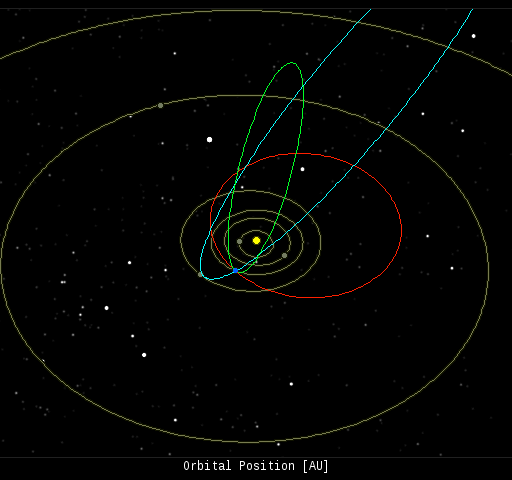When is the best time to see auroras? Where is the best place to go? And how do you photograph them? These questions and more are answered in a new book, Northern Lights - a Guide, by Pal Brekke & Fredrik Broms. | | | QUIET SUN: Solar activity is low. Two sunspots (AR2071 and AR2073) have 'beta-gamma' magnetic fields that harbor energy for M-class solar flares, but both are stable. A quiet weekend seems likely. Aurora alerts: text, voice MAY CAMELOPARDALID METEOR UPDATE: Note to sky watchers: That's not what a meteor storm looks like. Last night, as predicted, Earth passed through a stream of debris from Comet 209P/LINEAR, and the encounter did produce a number of fine meteors. However, contrary to some forecasts, there was no intense outburst. Typical naked-eye meteor rates were no more than 5 or 10 per hour, a far cry from the "meteor storm" some headlines anticipated. "Even though the meteor shower was less than spectacular, it was still nice to spend the night camping out under dark skies," says Kevin Palmer of Illinois. " I captured this fireball over the Green River State Wildlife Area at 2:24 am." 
The modest display was hardly surprising. The parent comet, 209P/LINEAR, is faint and currently produces only a small amount of dust. Most forecasters acknowledged that there might be less debris in Earth's path than their models suggested. It is worth noting, and perhaps marveling, that forecasters correctly predicted the onset of a never-before-seen meteor shower. They got the timing almost perfectly correct; only the rates were off. Such a prediction would have beeen impossible only 20 years ago before the development of physics-based dust stream models. In this respect, the May Camelopardalids were a success if not a spectacle. Realtime Meteor Photo Gallery
MEANWHILE IN THE STRATOSPHERE: As seen from ground level, the May Camelopardalids were a bit of a dud. But what was the shower like in the stratosphere? To find out, the students of Earth to Sky Calculus launched a helium balloon equipped with a low-light meteor camera. Here they are inflating the balloon and releasing it into the midnight sky above the Sierra Nevadas of central California: 
The balloon's 3 hour flight coincided with the predicted peak of the shower. During that time the payload was floating above 99% of Earth's atmosphere for almost an hour. The student's camera had a front row seat for the meteor display, such as it was. The next step is to recover the camera, which is not as easy as launching it. The payload and its digital cache of photos landed in a remote area of the Sierra Nevada backcountry. Tomorrow, a student recovery team will enter the Sierra National Forest tomorrow to retrieve the payload from a forested area near Paradise Peak. Stay tuned for updates. Realtime Space Weather Photo Gallery
Realtime Aurora Photo Gallery
Realtime Mars Photo Gallery
Realtime Comet Photo Gallery Every night, a network of NASA all-sky cameras scans the skies above the United States for meteoritic fireballs. Automated software maintained by NASA's Meteoroid Environment Office calculates their orbits, velocity, penetration depth in Earth's atmosphere and many other characteristics. Daily results are presented here on Spaceweather.com. On May. 24, 2014, the network reported 14 fireballs.
( 14 sporadics)  In this diagram of the inner solar system, all of the fireball orbits intersect at a single point--Earth. The orbits are color-coded by velocity, from slow (red) to fast (blue). [Larger image] [movies]
Potentially Hazardous Asteroids ( PHAs) are space rocks larger than approximately 100m that can come closer to Earth than 0.05 AU. None of the known PHAs is on a collision course with our planet, although astronomers are finding new ones all the time. On May 24, 2014 there were 1477 potentially hazardous asteroids. Recent & Upcoming Earth-asteroid encounters: | Asteroid | Date(UT) | Miss Distance | Size | | 1997 WS22 | May 21 | 47.1 LD | 1.5 km | | 2014 KO2 | May 21 | 5.2 LD | 10 m | | 2002 JC | May 24 | 48.7 LD | 1.4 km | | 2014 HQ124 | Jun 8 | 3.3 LD | 660 m | | 2011 PU1 | Jul 18 | 7.6 LD | 43 m | | 2002 JN97 | Aug 2 | 61.4 LD | 2.0 km | Notes: LD means "Lunar Distance." 1 LD = 384,401 km, the distance between Earth and the Moon. 1 LD also equals 0.00256 AU. MAG is the visual magnitude of the asteroid on the date of closest approach. | | The official U.S. government space weather bureau | | | The first place to look for information about sundogs, pillars, rainbows and related phenomena. | | | Researchers call it a "Hubble for the sun." SDO is the most advanced solar observatory ever. | | | 3D views of the sun from NASA's Solar and Terrestrial Relations Observatory | | | Realtime and archival images of the Sun from SOHO. | | | from the NOAA Space Environment Center | | | the underlying science of space weather | | 
